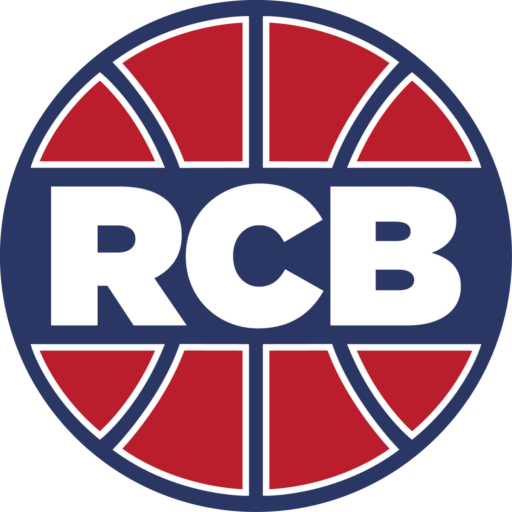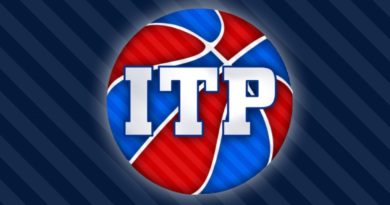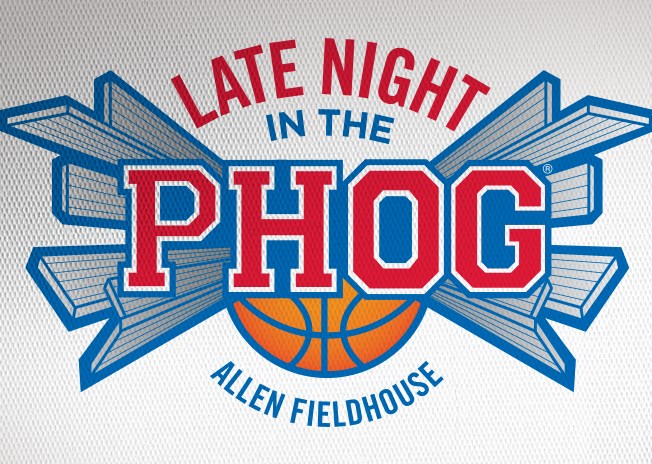Kentucky Cruises Against Kansas: Four Factors
After a 72-40 drubbing at the hands of the top-ranked Kentucky Wildcats, Bill Self needed a drink. He sat down for his post-game press conference, took a drink from a water bottle, and announced, “I was hoping that was vodka.” The coach wasn’t the only one needing a way to drown his sorrows as Kansas fans mourned the biggest defeat of the Bill Self era. Kentucky’s platoon strategy–or “reinforcements” as John Calipari calls them–simply wore down the Jayhawks throughout the game contributing to the worst offensive performance for Kansas since at least 1997-98, according to Jesse Newell of the Topeka Capital Journal. Unfortunately for Kansas, the most important statistic in basketball is shooting–both how well you shoot and how well you defend your opponent from shooting. On Tuesday night, Kansas simply couldn’t score.
As you can see in the above chart, the effective field goal percentage (eFG%) statistic heavily favored the Wildcats. Effective field goal percentage is a measure of how well a team shoots the ball with a slight adjustment for the value of 3-point shots since they are worth an additional point. The comparison of those first two columns is likely sufficient to explain the result in the Champions Classic. The Jayhawks struggled throughout the game with the length of the Kentucky Wildcats. Kentucky fields 10 players taller than 6-foot-6 and four players taller than 6-foot-10. They have, by far, the biggest team in college basketball this season.
When asked about his game plan, something I challenged last night, Self responded, “We play to our strengths, and you don’t just change offenses because the other team is tall. Our whole deal early on was drive to pass. And we didn’t; we drove to shoot.” The drive to pass strategy was successful at times when implemented well. Driving puts pressure on defenders to make decisions, and in the following clip, Aaron Harrison leaves Wayne Selden on the perimeter to close down on a Perry Ellis drive leading to an open Kansas 3-pointer.
However the pass wasn’t often the option for Kansas as their guards looked to penetrate into the Kentucky trees. In particular, starting point guard Frank Mason III struggled with the size of Kentucky often finding himself in the air with no shot to take. Here, Mason, a 5-foot-9 guard, drives immediately after a reset from a dead ball and is turned away by two Kentucky defenders.
Mason has a habit of falling away from the defender once contact is made, which, on more than one occasion created an opportunity for a second Kentucky player to block his shot. The Kansas guards needed to go into the chest of Kentucky’s bigs in an effort to draw fouls and get to the line. Freshman Devonte’ Graham opted for another option, looking to hit a floater over Karl-Anthony Towns early in the shot clock only the have it turned away.
The Jayhawks even rebounded their misses well on the offensive end, but simply weren’t able to convert those opportunities into points, finishing with only nine second chance points. What Kansas needed was patience. The Jayhawks needed to move the ball and allow plays to develop as they did here with freshman Sviatoslav Mykhailiuk utilizing the screens of Jamari Traylor and Cliff Alexander to hit one of Kansas’s three 3-pointers.
Kentucky isn’t the only team the Jayhawks will face this season with substantial size up front. The team many have predicted to challenge them for the Big 12 title, the Texas Longhorns, will feature players like Cameron Ridley and Myles Turner that will present similar problems to Kansas. Bill Self will need to prepare his team to challenge to move the ball and create better driving in order to challenge that length or encourage the Jayhawks to take more 3-point shots in order to avoid the length altogether.
Kansas is not as bad as they played on Tuesday night, but they are a team still in search of their identity that is often criticized by Self for not being where they’re supposed to be on offense. Luckily, the season is a long one and Kansas fans will remember that the last time they lost to Kentucky in the Champions Classic, they finished the season in the NCAA Tournament’s championship game.
This post originally appeared on Ain’t No Seats. Follow Chris over on Twitter @cstonehoops.










cialis pills 40mg – cialis 40 mg buy cialis canadian pharmacy
cialis 40mg – reputable canadian pharmacy cheap cialis pills
pills for ed – erectile dysfunction natural treatment non prescription ed pills
where to buy prednisone 5443 without prescription – prednisone daily use prednisone 20mg online without prescription
how to get viagra – where to buy cheap viagra in usa viagra tablet india
cialis generic in usa – Buy cialis overnight delivery how to buy cialis over the counter
ivermectin 500ml – stromectol cost uk ivermectin 3mg tabs
home remedies for erectile dysfunction – injections for ed him ed pills
cytotec canada – cytotec generic brand cytotec pills buy
doxycycline tab 100 mg – doxycycline without rx doxycycline buy no prescription
neurontin 400 mg tablets – levothyroxine 137 cost best prices for synthroid
viagra online from canada generic – can i buy viagra online in uk sildenafil discount coupon
cheapest pharmacy for prescriptions without insurance – cost of 10mg cialis
vardenafil generic levitra – site buy vardenafil online 24 hours
ivermectin cost australia – site buy stromectol uk
prednisone 20mg dosage – 15 mg prednisone daily prednisone 4mg tab
buy generic accutane 40 mg – 49 mg accutane isotretinoin 10 mg
rx amoxicillin 500mg – buy amoxicilin 500 mg amoxicillin 500 mg
methylprednisolone 16 mg buy – medrol 16mg tab lyrica 75 mg cost
thesis writers – help with term paper term papers help
20 mg sildenafil 30 tablets cost – Buy viagra in canada viagra buy india
buy cheap cialis from india – fspcia cialis 80mg
ivermectin otc – buy ivermectin pills ivermectin online pharmacy
prednisone purchase online – deltasone 5 mg drug prednisone 25g
generic lasix – order lasix without presciption no script generic lasix
ipratropium albuterol – ventoingo.com ventolin pills
cytotec online in south africa – buy cytotec online south africa cytotec cvs
doxycycline 10mg – buy prednisolone 5mg online prednisolone 20mg uk
ivermectin – ivermectin tablet price buy ivermectin online
ivermectin goodrx – stromectol ivermectin where to buy stromectol
generic sildenafil cost – silepilled.com online sildenafil
tadalafil dosage – tadalapills best place to buy tadalafil online reviews
accutane over the counter canada – generic accutane rx cost where can i buy accutane
buy custom research paper – cheap term papers help with writing a research paper
ivermectin human – stromectol generic ivermectin 15 mg
plaquenil brand name – hydroxychloroquine and psoriasis generic prednisone 40mg online
vidalista tadalafil 60 – kamagra 100 cenforce 25 usa and uk
xenical and thyroid medications – orlistat 60 mg xenical reviews videos
stromectol buy uk – stromectol pills ivermectin cream canada cost
sildenafil 130mg otc – viagra australia sildenafil cream
200 mg cialis – real cialis without prescription cialis from canada online pharmacy
generic cialis cheap – about cialis buy generic cialis online with mastercard
prednisone over the counter australia – generic prednisone online 20 mg prednisone daily
ivermectin 5 – stromectol australia buy ivermectin online
ivermectin 3 mg – ivermectin for people side effects of ivermectin
can i buy viagra in india – viagra 100mg england where to get viagra tablets
sildenafil 100g – cheap viagra black order sildenafil from canada
cheap cialis in australia – cialis coupon walmart cialis in mexico price
online med pharmacy – Cialis online us buy generic cialis australia
ivermectin 0.1 – ivermectin uk ivermectin 1
ivermectin oral – ivermectin human ivermectin india
vegas casino online – casino slots gambling online slots real money
cheap dissertation help – academic writing pay for a research paper
viagra best price – Buy pfizer viagra in canada buy cheap viagra online from india
stromectol 6mg – ivermectin buy ivermectin 6 mg tablets
stromectol tab price – stromectol uk buy ivermectin order online
prednisone best price – purchase prednisone online 10mg prednisone daily
Yes! Finally something about quotes.
You can certainly see your enthusiasm in the work you write.
The sector hopes for even more passionate writers such as you
who are not afraid to say how they believe. Always go after your heart.
What’s up, after reading this remarkable piece of writing i am as well glad
to share my knowledge here with mates.
One group, the intervention group, listened to relaxing music that was played at night through a music player in an ergonomic pillow.
What’s Happening i am new to this, I stumbled upon this I have found
It positively useful and it has helped me out loads. I
am hoping to contribute & assist other users like its helped me.
Good job.
Computer hardware includes the different elements of a desktop computer, including the hard disk,
central processing system, graphic card, hard drive, keyboard, computer
mouse, display, motherboard as well as the numerous processors.
A chip is a small circuit which includes the logic that enables
a device to interact with software program or hardware.
There are several sorts of chips as well as different
companies make them depending upon their usages.
A microprocessor is among the major parts in a desktop computer system.
It controls the computer features of the device. The microprocessor is configured
in an integrated circuit which can be published on paper or
set right into a memory chip. The chips can store guidelines for a tool to perform a specific task.
Instructions are packed from an external device or they can be loaded into the microprocessor.
A hypervisor belongs of the equipment that allows communication in between different tool vehicle
drivers and running systems. It allows a gadget to act like a digital machine in a computing system.
It likewise allows communication in between the
gadget as well as os. Some hypervisors are equipment based while others are
software based.
An ingrained tool is a kind of equipment that is made use of in some sorts
of digital home appliances. These devices are developed directly right into a home appliance as well as it works as an input or output device.
They are utilized to send guidelines or information from the tool
to the appliance or to various other devices. For example, an ingrained
tool may include a printer, scanner or video camera to develop
a digital printer, scanner or cam in a digital device.
You should take part in a contest for one of the best sites on the net.
I’m going to recommend this website!
Attractive component to content. I just stumbled upon your weblog
and iin accession capital to say that I get in fact enjoyed account your blog posts.
Any way I’ll bee subscribing iin your augment
oor even I fulfillment you get right of entry to consistently quickly.
webpage
Hi there Dear, are you in fact visiting this web
page on a regular basis, if so afterward you will definitely obtain nice
know-how.
Cann I simply say what a omfort to uncover someone who actually understands what they’re discussing online.
You certainly now hoow to bring a problem to light and make it important.
More people should check this out and understand thius sixe of thee story.
I was surprised you are not more popular given that you surely possess the gift.
에이 렉스 web site 페이팔을 수락하는
증권 중개인
I like the valuable info you provide in your articles.
I’ll bookmark your weblog and check again here regularly.
I am quite certain I’ll learn many new stuff right here!
Good luck for the next!
Hi! I’m at work browsing your blog from my new iphone!
Just wanted to say I love reading your blog and look forward to all your posts!
Carry on the fantastic work!
accutane price usa – site accutane prescription cost uk
purchase amoxil 1000mg usa – amoxicillin without a doctor’s prescription buy amoxicillin 500mg canada
ivermectin 3 mg oral – topical ivermectin cost buy ivermectin 12 mg
stromectol canada – mectolpl.com ivermectin 18mg
ivermectin 0.5 lotion – ivermectin for humans stromectol for humans for sale
the canadian pharmacy – canadian pharmacy cheap generic drugs
erection pills that work – buy ed pills online cheap erectile dysfunction pills online
where can you get prednisone – prednisone 40mg cheap prednisone 20 mg
prednisone dosage – prednisplus 1.5 prednisone
accutane us – buy accutane usa accutane 40 mg cost
Munna Bhai Sallu Bhai movie download in 720p Abbey
LeifElkins
Silent Hunter 5 Product Key Crack 16 Les Mills Body Attack 80 Torrent.rar Shrii
Muhurta 13 Portable Astrology Software
Thanks for any other great post. The place else may anyone
get that type of info in such an ideal manner of writing?
I have a presentation subsequent week, and I’m at the search for such info.
Enjoyed examining this, very good stuff, appreciate it.
I do consider all of the ideas you have presented on your post.
They’re very convincing and will definitely work. Still, the posts are very short for starters.
May just you please lengthen them a bit from next time?
Thank you for the post.
purchase amoxicillin 250mg uk – amoxicillin price amoxil no prescription
free slots online – real online casino best online casino usa
It’s perfect time to make some plans for the future and it is time to be happy. I’ve read this post and if I could I wish to suggest you few interesting things or advice. Perhaps you could write next articles referring to this article. I want to read even more things about it!|
ivermectina online – ivermectin for sale ivermectin us